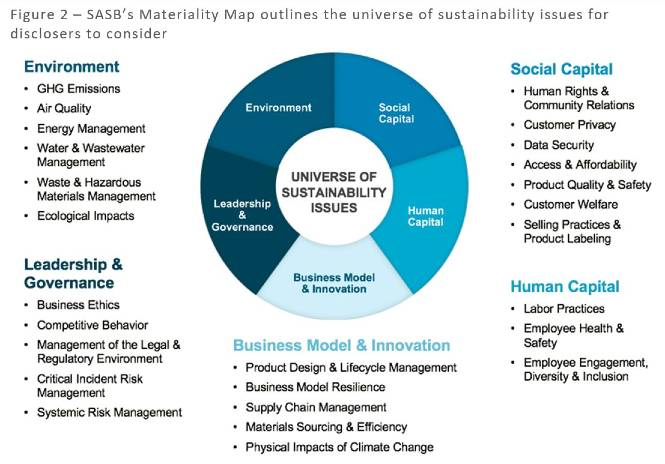The Sustainability Accounting Standards Board (SASB) framework is quickly becoming the de facto global standard for corporate sustainability disclosure.
We detailed the growing momentum behind sustainability reporting in a previous blog post. We concluded that sustainability reporting is no longer optional for publicly traded companies and there is coalescence around two disclosure standards: the Task Force on Climate-related Financial Disclosure (TFCD) and SASB. Last month, we provided an in-depth analysis of the TCFD framework and highlighted considerations for sustainability managers looking to build a TCFD-aligned disclosure. In this post, we take a closer look at SASB. What is it? Why is it important? What does it say? And how can my company comply?
What is SASB?
In 2011, the SASB Foundation set out to establish disclosure standards across a diverse array to ESG (Environmental, Social, and Governance) topics. The standard recognizes that each industry is unique and therefore needs a unique set of relevant ESG topic areas. In total, there are 77 different industry standards that have been developed by SASB (see Figure 1). These standards identify the minimal financially material sustainability topics and metrics.

Why is SASB important?
1) Sustainable investment is growing
SASB is important because sustainable investment is becoming an increasingly prominent investment philosophy. SASB not only helps to address the proliferation of disclosure frameworks, but also helps to harmonize reporting standards to allow for consistent comparison across sustainable investments. SASB also provides clarity and simplicity to corporate-issuer disclosures. Gone are the days where companies need to navigate a slew of overlapping sustainability frameworks.
2) Regulation drives sustainable investment
Regulation is also driving the trend toward investor interest in sustainable investing. BlackRock outlines the regulatory trends in detail. Here we highlight regulatory trends in three markets:
Canada: The Canadian Securities Administrators (CSA) issued Staff Notice 51-358 to address the growing interest among issuers and investors in voluntary disclosure regimes, including the TCFD and SASB frameworks.
United States: Sustainability-related risk is governed by the Securities and Exchange Commission’s (SEC) traditional materiality standard.
Europe: Through its Action Plan for sustainable finance, the EU has set out to build a comprehensive agenda to incorporate sustainability into the existing regulatory approach for financial markets.
3) SASB is the leading disclosure standard
As referenced above, there is a proliferation of disclosure frameworks. Frameworks include CDSB (Climate Disclosure Standards Board), GRI (Global Reporting Initiative), IIRC (International Integrated Reporting Council), the CDP, and more. While each offers a slightly different focus, SASB appears to be the clear front-runner for providing a comprehensive set of standards for reporting sustainability information across a wide range of issues.
What does SASB say?
With an understanding of what SASB is and why it is important, we now provide details of the SASB disclosure framework itself. SASB’s sustainability topics are organized under five broad sustainability dimensions. These topics include:
- Environment
- Social Capital
- Human Capital
- Business Model and Innovation
- Leadership and Governance
These topics form what SASB refers to as their Materiality Map (see Figure 2). Each industry has its own unique set of corporate activities and a unique sustainability profile. Therefore, the disclosure topics included in your industry’s specific disclosure standard will be a sub-set of this universe of sustainability issues.

How can my company comply?
The reporting company’s journey will vary depending on the sector or sectors that are applicable to your operating activities. Regardless of what sector your company operates in, the SASB standards include four common areas:
- Disclosure topics
- Accounting metrics
- Technical protocols
- Activity metrics
The first step towards a SASB-aligned sustainability disclosure is to download the current standard that is most applicable to your sector. As you work through the standard, we suggest that sustainability managers take the following steps:
- Ensure your organization has the proper risk management and governance process in place.
- Seek to integrate sustainability risk into your company’s existing risk management framework.
- Robust disclosure requires good data. Have the right tools in place to measure and track key sustainability-related metrics. This is particularly important for the more quantitatively driven environmental data.
Conclusion
Investors see a correlation between long-term profitability and corporate transparency. Companies have a responsibility to provide investors with the information that will impact investment decisions. This includes sustainability-related information. This not only helps investment decision-making but will become increasingly important for a company’s ability to attract capital in the future. In short, sustainability disclosure is no longer voluntary. Now is the time to start your SASB-aligned disclosure.
For additional information or to discuss this topic further, please visit Frostbyte’s website or contact Andrea Korney directly at [email protected]




